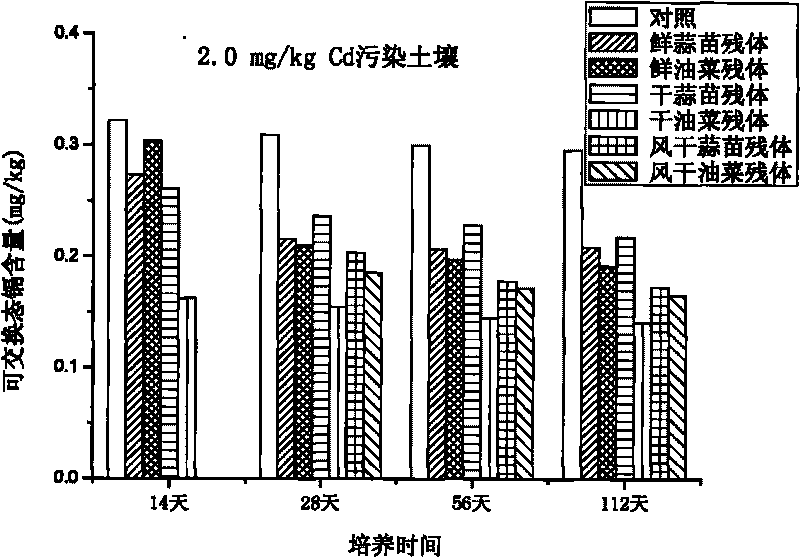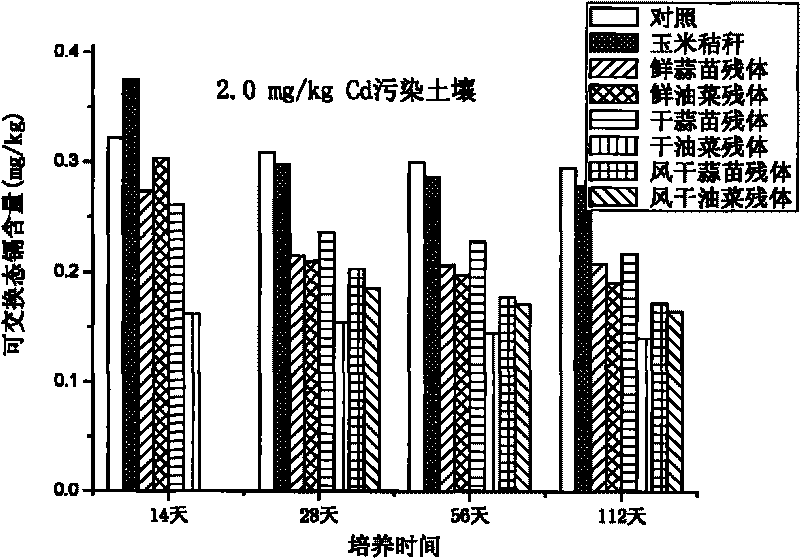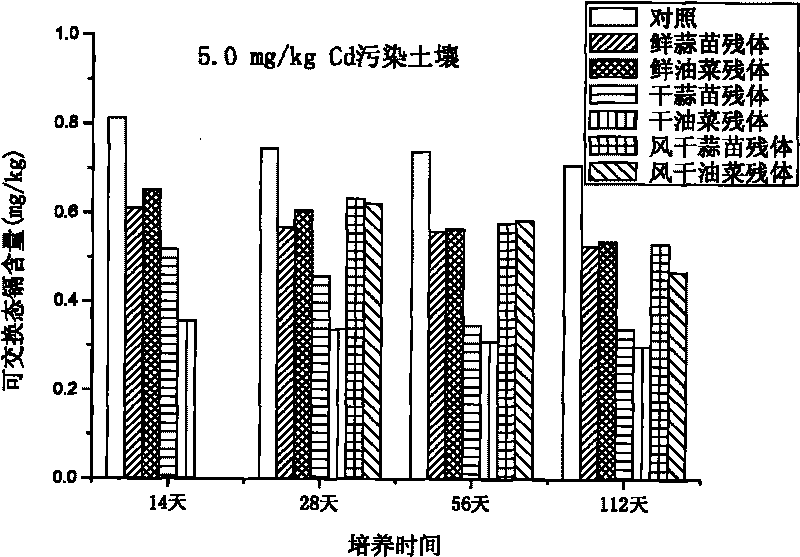Method for restoring cadmium pollution of soil in passivation mode
A technology for remediating soil and cadmium pollution, which is applied in the field of passivation and remediation of soil cadmium pollution, can solve the problems that the land can no longer be used for food production, the pollution degree is not very serious, and the food production cannot be carried out, so as to achieve environmental friendliness, low restoration costs, The effect of increasing the productivity of the land
- Summary
- Abstract
- Description
- Claims
- Application Information
AI Technical Summary
Problems solved by technology
Method used
Image
Examples
Embodiment 1
[0028] Remediation and effects of garlic seedling residues, rapeseed residues and corn stalks on heavy metal cadmium (Cd) polluted soil:
[0029] 1. Test materials and methods
[0030] (1) Soil treatment:
[0031] Pass the soil through a 1mm sieve (for chemical extraction test), and set the soil cadmium pollution level to 2mg.kg -1 Cd, 5mg.kg -1 , Balanced culture aging, about one month.
[0032] (2) Preparation of passivation material:
[0033] a. Fresh plant residues: Garlic seedlings, rapeseed, and corn stalks are crushed into residues less than 1 cm in length.
[0034] b. Garlic seedlings and rapeseed samples were dried at 75°C and garlic seedlings and rapeseed were naturally air-dried at 28°C, and the air-dried samples were ground and passed through a 20-mesh sieve.
[0035] (3) Method:
[0036] Weigh 2.0g, 2mg.kg -1 Cd soil, add 0.02g of fresh plant residue, the dry matter content of the added air-dried sample and the dried sample is the same as the dry matter con...
Embodiment 2
[0047] Effects of garlic seedling residues, rapeseed residues and corn stalks on cadmium content in seedlings of crops grown in heavy metal cadmium (Cd)-contaminated soil under indoor pot passivation test conditions:
[0048] (1) Test soil: brown fluvo-aquic soil from Beijing Changping Experimental Station, passed through a 2mm sieve. Set soil cadmium pollution level to 2mg.kg -1 Cd, 5mg.kg -1 , balanced culture aging, about one month;
[0049] (2) Type selection of passivating agent for testing: garlic seedling residue, corn stalk;
[0050] (3) selection of test plant species: cucumber
[0051] (4) Method: the addition amount of garlic seedling residue and corn stalk (fresh sample) is set to 0.1%, 0.4%, 1% (weight percentage of soil). The above-ground organisms were harvested after 6 weeks of growth, and their biomass (average plant weight) was measured. Kill at 105°C, dry at 75°C, grind, weigh about 0.5g, digest with concentrated HNO3, and measure the Cd content in the ...
Embodiment 3
[0056] Remediation and effects of mustard residues, cabbage residues, green onion residues, and leek residues (all fresh plant residues) on soil contaminated by heavy metal cadmium (Cd):
[0057] Processing method is identical with the method for embodiment 1. The test results show that the above four plant residues have a good effect on the remediation of cadmium pollution in the soil. After 56 days, the reduction of available cadmium in the soil is more than 20%, which has a good remediation effect on soil cadmium pollution.
[0058] In the implementation example of the present invention, garlic, scallions, and leeks belong to Liliaceae plants, and the residues are rich in organic sulfur. The plant residues in the present invention are rich in sulfhydryls, which means that the sulfhydryl content (dry weight) in the plant residues reaches more than 2.0%. , the content of mercapto groups (dry weight) in the residue of garlic seedlings reaches (4.44±0.11)%. There will be a pung...
PUM
| Property | Measurement | Unit |
|---|---|---|
| Length | aaaaa | aaaaa |
Abstract
Description
Claims
Application Information
 Login to View More
Login to View More - R&D
- Intellectual Property
- Life Sciences
- Materials
- Tech Scout
- Unparalleled Data Quality
- Higher Quality Content
- 60% Fewer Hallucinations
Browse by: Latest US Patents, China's latest patents, Technical Efficacy Thesaurus, Application Domain, Technology Topic, Popular Technical Reports.
© 2025 PatSnap. All rights reserved.Legal|Privacy policy|Modern Slavery Act Transparency Statement|Sitemap|About US| Contact US: help@patsnap.com



